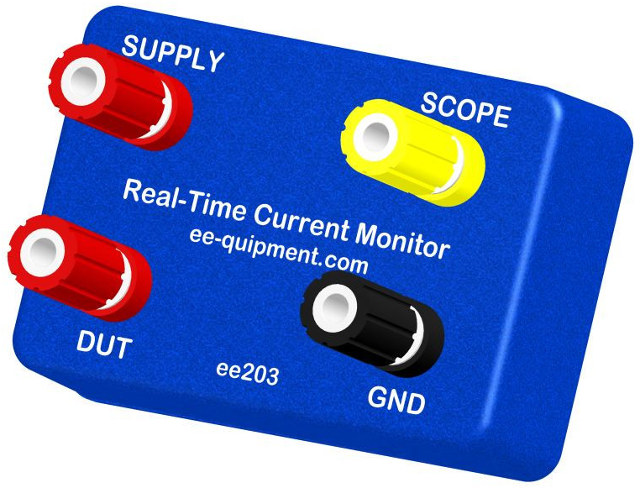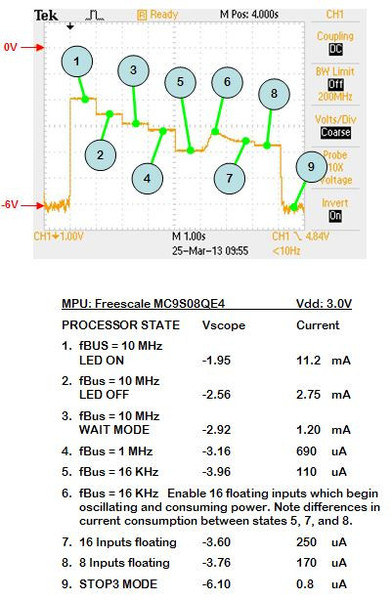Measuring current can be tricky, as I found out during my various attempts at measuring power consumption of TV boxes, as when the current gets too high, your measurement setup impedance may be too high (cables or multimeter), and the voltage delivered to the device under test too low for it too keep running, while accuracy may be an issue while measuring very low currents. EE Equipment ee203 Current Monitor solves some of these issues for people working on low power embedded systems as it can measure currents between 1 μA and 1A, and even output data to an oscilloscope to see real-time power consumption of the devices.
 Key features for ee203 current monitor:
Key features for ee203 current monitor:
 6 Decades of Current Range: 1 μA – 1 A (2A fuse)
6 Decades of Current Range: 1 μA – 1 A (2A fuse)- No Range-Switching Interruptions or Delays
- Wide System Voltage Range 1.5V – 5.5V (12V Max)
- USB interface for calibration, control, and data logging
- View Current Graphically in Real-Time on any Oscilloscope
- SCOPE Output Voltage: 0 to 6V
- Measurement Error – Min: +/- 1μA (DUT current); Max: +/- 60mV (Oscilloscope Output Voltage)
- Bandwidth – 1000 Hz min.
The tricky part the device solves is switching between different current ranges without interruption, which means you can monitor current spikes on an oscilloscope and via a CSV fie that you can retrieve via USB. ee203 is the second version of the tools, as ee201 was launched previously, and adds a USB port, self-calibration support and more.
The chart on the right shows an MCU platform’s current profile as it jumps from 0.8 μA in STOP mode to over 11 mA in active mode, current fluctuates depending on the processor state.
A small test board is available with a range of current sink options from 10 uA to 100 mA, and an MCU capable of running in different power modes.
ee203 monitor sells for $195.95, while the demo board goes for $9.95. Further details and purchase links can be found on EE Equipment ee203 product page.
Via Embedded.com

Jean-Luc started CNX Software in 2010 as a part-time endeavor, before quitting his job as a software engineering manager, and starting to write daily news, and reviews full time later in 2011.
Support CNX Software! Donate via cryptocurrencies, become a Patron on Patreon, or purchase goods on Amazon or Aliexpress





A cad drawing instead of a product photo scares me a little bit..
Dave Jones from the eevblog sells a similar device for $90
https://eevblog.myshopify.com/products/ucurrent
Of course, you have to supply a meter, and hook it up to a pc, if you want to digitize the readings like ee203
Here’s some more on both the RTCM and uCurrent:
http://www.embedded.com/electronics-blogs/break-points/4440109/Real-Time-Current-Monitor-Rev-2
When “measuring power consumption of TV boxes” you can not only measure the current because that never is in sync with voltage. Measuring current only is highly misleading.
I recommend true power meters showing their measurement in Watts.
@LinAdmin
Do you mean like a kill-a-watt? Or is there something better?
@Jean-Luc Aufranc (CNXSoft)
Exactly!
This kind of instrument has a built-in multiplier which constantly (or at many fixed interpolation points during one cycle) multiplies momentous voltage and current and therefore gives true power consumption in watts.
You can check it by measuring a purely capacitive load like a 100nF/400V capacitor. This will show some current (mA) but almost no power (mW).
@LinAdmin
OK, but that kind of device is not really accurate either for things that consume little current.
I’m not sure there are models where I can get the data to my computer either.
@Jean-Luc Aufranc (CNXSoft)
My watt-meter with Swiss power sockets has accuracy of 0.5 Watt, which is not perfect but for my purpose good enough.
Just measuring current and multiplying by your mains voltage will in most cases give 10 times higher errors!!!
You should never forget that measuring current alone for determining power consumption is useful only for purely resistive loads where the current is a pure sine _exactly in phase_ with voltage.
@LinAdmin I measured the 5V DC input, and yes, as the current increases, the voltage drops a bit due to the low impedance resistance used for current. I guess both methods have their advantages. Kill-a-watt is very easy, and good to get measurements for different states like standby, power off, and active. It also includes power consumption for both the device and power supply. Using a multimeter to measure current is bit more difficult, but I could draw some power profiles (e.g. for different steps in Antutu), which may not be possible with a kill-a-watt type of device. It also… Read more »